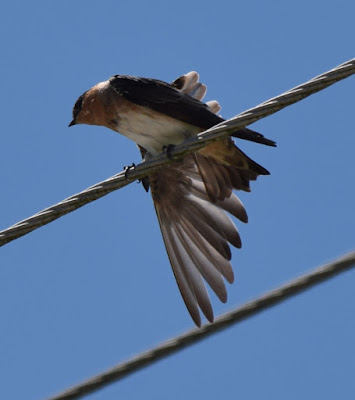I was on the road by 4:30 this morning, driving toward the moon and hoping to see the sun rise over the coast. My weather app said the moon was 99% full, or something crazy like that. I've been hearing about a "super moon," and I may have been a day early for that, but when the moon turned orange on its way down, it looked pretty super to me.
It was morning twilight when I hit Holly Beach, but there were already gull flocks behind the shrimp boats just offshore. Riding with the windows down felt great, almost chilly. There weren't many people on the beach, just a few zipped tents, but the birds were a bit jumpy in the half-light.
Beach birds were typical, lots of Laughing Gulls and assorted terns with a few young birds mixed in. The only exception I noticed was a confused Marbled Godwit that walked up to see what I was.
Peveto was still wet with dew, but a recent mowing made it easy to walk around without getting soaked. The temperature was perfect, and bugs were few.
 |
| (Hey now, what's that's hiding on this Kosteletzkya?) |
 |
| Painted Lady* |
I made sure to take photos of the butterflies and moths so someone else can ID them for me*. I did see a Monarch today, always a welcome fall sight.
 |
| Fiery Skipper* |
 |
| Question Mark* |
 |
| Alanthus Webworm Moth* |
And apparently the alligators do, too.
There were hundreds of Black Terns, dozens of spoonbills, and hundreds of Snowy and Great Egrets. A stealth white Reddish Egret was present as well.
Inside of the levees there were hundreds of shorebirds. Peeps were in roadside puddles as well. It was interesting to see fresh juvenile peeps like the Semipalmated Sandpiper below rubbing shoulders with molting Boat-tailed Grackles.
I had a couple of interesting arthropods there as well. As I was walking through the field around the woods, a small butterfly moved ahead of me. It landed on a morning glory and then suddenly appeared to flop on its side. I knew what that meant. Remember the spider on the Kosteletzkya flower above? It has cousins at Lighthouse.
I guess that's a Pygmy Blue** it has in its grip. Whatever it is, it looks larger on my monitor than it did in real life. I'd call it a pygmy.
Birdwise, Lighthouse Woods was slow but interesting. A White-tailed Kite was there when I arrived. I managed a long-distance snap through the spotting scope that's OK but fails to do this beautiful bird justice.
Also present in the woods were Hooded Warbler, Scissortails, and a Baltimore Oriole.
As mentioned, the bugs were bad, but at least the giant ragweed wasn't. The magnificent stand of ragweed will be manna for the birds if it doesn't get mowed before it blooms and sets seed. It will be an allergic nightmare for allergy sufferers like me, though, and it's this closing to blooming:
After Lighthouse I headed to Hackberry Ridge/Secret Place. It held a couple of Prairie Warblers, more empid flycatchers, and surprisingly only a few Blue-gray Gnatcatchers.
The wires on the way in held a nice group of swallows, including some formerly rare Cave Swallows mixed in with Bank and Barn swallows.
The Cave Swallows were preening, and I managed to get snaps of their stretches that show their open wings. Both show molt in progress in their primaries. The molt must be almost at a stopping point because the outer primaries are usually older and paler than the rest of the outer wing when we see them passing through in October.
I wrapped the day up after Secret Place, heading back early. What had started out as a temperate day had become bright, hot, and dry. Fall migration is just getting underway. There'll be other days.
*Thanks to Charlie Lyon for doing so; see all asterisked leps.
**Thanks to Charlie again for letting me know it's a Western Pygmy Blue. I know that Dave Patton has told me that many times, but...























